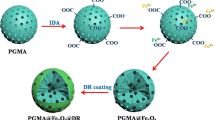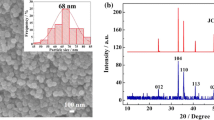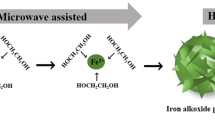Abstract
Magnetic polymer microspheres (MPMs) have been frequently used in contemporary wastewater treatment technology because of their efficient adsorption and separation capabilities. However, the magnetization efficiency of polymer microspheres cannot be effectively enhanced using the reported template methods. In this study, a novel template method for preparing MPMs was developed. Magnetic P(MMA-co-GMA)@Fe3O4@PMAA microspheres (mPFPMs) were created with a high magnetic content, homogeneous particle size distribution, and carboxylated surfaces. Compared with the conventional template methods, this method avoids the generation of free magnetic nanoparticles and improves the magnetic content of MPMs, as well as imparting carboxyl functional groups to the mPFPMs. The mPFPMs can be used to adsorb contaminants quickly and effectively. The results of the adsorption process were preferably fitted to the Langmuir isotherm (R2 = 0.998) with a maximum adsorption capacity of 124.9 mg/g and followed the pseudo-second-order kinetic model. Besides, the mPFPMs adsorbent showed better reusability for ten cycles with high adsorption properties. Therefore, this work proposed a novel and facile strategy to prepare MPMs that exhibited significant potential application value in many fields.









Similar content being viewed by others
References
Zhao X, Wang X, Lou T (2021) Preparation of fibrous chitosan/sodium alginate composite foams for the adsorption of cationic and anionic dyes. J Hazard Mater 403:124054. https://doi.org/10.1016/j.jhazmat.2020.124054
Mohammed N et al (2021) Selective adsorption and separation of organic dyes using functionalized cellulose nanocrystals. Chem Eng J 417:129237. https://doi.org/10.1016/j.cej.2021.129237
Liu C et al (2020) Fabrication and investigation on Ag nanowires/TiO2 nanosheets/graphene hybrid nanocomposite and its water treatment performance. Adv Compos Hybrid Mater 3(3):402–414. https://doi.org/10.1007/s42114-020-00164-2
Qi K et al (2020) Transition metal doped ZnO nanoparticles with enhanced photocatalytic and antibacterial performances: experimental and DFT studies. Ceram Int 46(2):1494–1502. https://doi.org/10.1016/j.ceramint.2019.09.116
Nippatla N, Philip L (2019) Electrocoagulation-floatation assisted pulsed power plasma technology for the complete mineralization of potentially toxic dyes and real textile wastewater. Process Saf Environ Prot 125:143–156. https://doi.org/10.1016/j.psep.2019.03.012
Liu Q et al (2020) Superior adsorption capacity of functionalised straw adsorbent for dyes and heavy-metal ions. J Hazard Mater 382:121040. https://doi.org/10.1016/j.jhazmat.2019.121040
Kazak O, Eker YR, Akin I, Bingol H, Tor A (2017) A novel red mud@sucrose based carbon composite: preparation, characterization and its adsorption performance toward methylene blue in aqueous solution. J Environ Chem Eng 5(3):2639–2647. https://doi.org/10.1016/j.jece.2017.05.018
Wang W, Tian G, Zhang Z, Wang A (2015) A simple hydrothermal approach to modify palygorskite for high-efficient adsorption of Methylene blue and Cu(II) ions. Chem Eng J 265:228–238. https://doi.org/10.1016/j.cej.2014.11.135
Wan X, Rong Z, Zhu K, Wu Y (2022) Chitosan-based dual network composite hydrogel for efficient adsorption of methylene blue dye. Int J Biol Macromol 222:725–735. https://doi.org/10.1016/j.ijbiomac.2022.09.213
Zhou S et al (2022) Montmorillonite-reduced graphene oxide composite aerogel (M−rGO): a green adsorbent for the dynamic removal of cadmium and methylene blue from wastewater. Sep Purif Technol 296:121416. https://doi.org/10.1016/j.seppur.2022.121416
Al-Shemy MT, Al-Sayed A, Dacrory S (2022) Fabrication of sodium alginate/graphene oxide/nanocrystalline cellulose scaffold for methylene blue adsorption: kinetics and thermodynamics study. Sep Purif Technol 290:120825. https://doi.org/10.1016/j.seppur.2022.120825
Gao T, Guan G, Wang X, Lou T (2022) Electrospun molecularly imprinted sodium alginate/polyethylene oxide nanofibrous membranes for selective adsorption of methylene blue. Int J Biol Macromol 207(March):62–71. https://doi.org/10.1016/j.ijbiomac.2022.02.193
Jawad AH, Abdulhameed AS (2020) Mesoporous Iraqi red kaolin clay as an efficient adsorbent for methylene blue dye: adsorption kinetic, isotherm and mechanism study. Surf Interfaces 18:100422. https://doi.org/10.1016/j.surfin.2019.100422
Bello K, Sarojini BK, Narayana B, Rao A, Byrappa K (2018) A study on adsorption behavior of newly synthesized banana pseudo-stem derived superabsorbent hydrogels for cationic and anionic dye removal from effluents. Carbohydr Polym 181:605–615. https://doi.org/10.1016/j.carbpol.2017.11.106
Wang N, Ma W, Ren Z, Du Y, Xu P, Han X (2018) Prussian blue analogues derived porous nitrogen-doped carbon microspheres as high-performance metal-free peroxymonosulfate activators for non-radical-dominated degradation of organic pollutants. J Mater Chem A 6(3):884–895. https://doi.org/10.1039/C7TA08472B
Santoso E, Ediati R, Kusumawati Y, Bahruji H, Sulistiono DO, Prasetyoko D (2020) Review on recent advances of carbon based adsorbent for methylene blue removal from waste water. Mater Today Chem16:100233. https://doi.org/10.1016/j.mtchem.2019.100233
Lee J, Patel R (2022) Wastewater treatment by polymeric microspheres: a review. Polymers (Basel) 14:9. https://doi.org/10.3390/polym14091890
Sun X et al (2014) Amino-functionalized magnetic cellulose nanocomposite as adsorbent for removal of Cr(VI): synthesis and adsorption studies. Chem Eng J 241:175–183. https://doi.org/10.1016/j.cej.2013.12.051
Shao Y, Zhou L, Bao C, Ma J, Liu M, Wang F (2016) Magnetic responsive metal–organic frameworks nanosphere with core–shell structure for highly efficient removal of methylene blue. Chem Eng J 283:1127–1136. https://doi.org/10.1016/j.cej.2015.08.051
Tai Y, Wang L, Gao J, Amer WA, Ding W, Yu H (2011) Synthesis of Fe3O4@poly(methylmethacrylate-co-divinylbenzene) magnetic porous microspheres and their application in the separation of phenol from aqueous solutions. J Colloid Interface Sci 360(2):731–738. https://doi.org/10.1016/j.jcis.2011.04.096
Wang C, Yan J, Cui X, Wang H (2011) Synthesis of raspberry-like monodisperse magnetic hollow hybrid nanospheres by coating polystyrene template with Fe3O4@SiO2 particles. J Colloid Interface Sci 354(1):94–99. https://doi.org/10.1016/j.jcis.2010.09.078
Li Z, Wang Z, Wang C, Ding S, Li F, Lin H (2019) Preparation of magnetic resin microspheres M-P(MMA-DVB-GMA) and the adsorption property to heavy metal ions. Appl Surf Sci 496:143708. https://doi.org/10.1016/j.apsusc.2019.143708
Jiang J, Sun X, Li Y, Deng C, Duan G (2018) Facile synthesis of Fe3O4@PDA core-shell microspheres functionalized with various metal ions: a systematic comparison of commonly-used metal ions for IMAC enrichment. Talanta 178:600–607. https://doi.org/10.1016/j.talanta.2017.09.071
Xu Z, Xia A, Wang C, Yang W, Fu S (2007) Synthesis of raspberry-like magnetic polystyrene microspheres. Mater Chem Phys 103(2–3):494–499. https://doi.org/10.1016/j.matchemphys.2007.02.074
Gao J, Ran X, Shi C, Cheng H, Cheng T, Su Y (2013) One-step solvothermal synthesis of highly water-soluble{,} negatively charged superparamagnetic Fe3O4 colloidal nanocrystal clusters. Nanoscale 5(15):7026–7033. https://doi.org/10.1039/C3NR00931A
Sun X, Yang L, Li Q, Liu Z, Dong T, Liu H (2015) Polyethylenimine-functionalized poly(vinyl alcohol) magnetic microspheres as a novel adsorbent for rapid removal of Cr(VI) from aqueous solution. Chem Eng J 262:101–108. https://doi.org/10.1016/j.cej.2014.09.045
Zhang B, Zhang H, Fan X, Li X, Yin D, Zhang Q (2013) Preparation of thermoresponsive Fe3O4/P(acrylic acid-methyl methacrylate-N-isopropylacrylamide) magnetic composite microspheres with controlled shell thickness and its releasing property for phenolphthalein. J Colloid Interface Sci 398:51–58. https://doi.org/10.1016/j.jcis.2013.01.042
Liu T et al (2019) Tailor-made core/shell/shell-like Fe3O4@SiO2@PPy composites with prominent microwave absorption performance. J Alloys Compd 779:831–843. https://doi.org/10.1016/j.jallcom.2018.11.167
Cvek M et al (2015) A facile controllable coating of carbonyl iron particles with poly(glycidyl methacrylate): a tool for adjusting MR response and stability properties. J Mater Chem C 3(18):4646–4656. https://doi.org/10.1039/C5TC00319A
Dresco PA, Zaitsev VS, Gambino RJ, Chu B (1999) Preparation and properties of magnetite and polymer magnetite nanoparticles. Langmuir 15(6):1945–1951. https://doi.org/10.1021/la980971g
Zhang Y, Liu R, Hu Y, Li G (2009) Microwave heating in preparation of magnetic molecularly imprinted polymer beads for trace triazines analysis in complicated samples. Anal Chem 81(3):967–976. https://doi.org/10.1021/ac8018262
Arora G et al (2021) Fabrication{,} functionalization and advanced applications of magnetic hollow materials in confined catalysis and environmental remediation. Nanoscale 13(25):10967–11003. https://doi.org/10.1039/D1NR01010G
Liu S et al (2016) Magnetically separable and recyclable Fe3O4–polydopamine hybrid hollow microsphere for highly efficient peroxidase mimetic catalysts. J Colloid Interface Sci 469:69–77. https://doi.org/10.1016/j.jcis.2016.02.011
Wang J, Zhang W, Qian Y, Deng B, Tian W (2016) pH, temperature, and magnetic triple-responsive polymer porous microspheres for tunable adsorption. Macromol Mater Eng 301(9):1132–1141. https://doi.org/10.1002/mame.201600161
Nie Y, Luo Y, Luo S, Cao X, Song G, Deng C (2022) Amphiphilic copolymers grafted on monodisperse magnetic microspheres as an efficient adsorbent for the extraction of safrole in the plasma. J Chromatogr A 1662:462733. https://doi.org/10.1016/j.chroma.2021.462733
Yu B, He L, Wang Y, Cong H (2017) Multifunctional PMMA@Fe3O4@DR magnetic materials for efficient adsorption of dyes. Materials (Basel) 10(11):1–12. https://doi.org/10.3390/ma10111239
Dong Y, Wang S, Choi HJ (2022) Poly(N-methylaniline)/magnetite microsphere and its electrical and magnetic dual responses. Polymer (Guildf) 240:124492. https://doi.org/10.1016/j.polymer.2021.124492
Cao X et al (2019) Fabrication of functionalized magnetic microspheres based on monodispersed polystyrene for quantitation of allyl-benzodioxoles coupled with gas chromatography and mass spectrometry. J Chromatogr A 1607:460402. https://doi.org/10.1016/j.chroma.2019.460402
de la Escosura-Muñiz A, Plichta Z, Horák D, Merkoçi A (2015) Alzheimer’s disease biomarkers detection in human samples by efficient capturing through porous magnetic microspheres and labelling with electrocatalytic gold nanoparticles. Biosens Bioelectron 67:162–169. https://doi.org/10.1016/j.bios.2014.07.086
Yang X, Chen L, Han B, Yang X, Duan H (2010) Preparation of magnetite and tumor dual-targeting hollow polymer microspheres with pH-sensitivity for anticancer drug-carriers. Polymer (Guildf) 51(12):2533–2539. https://doi.org/10.1016/j.polymer.2010.04.032
Horák D, Hlidková H, Klyuchivska O, Grytsyna I, Stoika R (2017) PEGylation controls attachment and engulfment of monodisperse magnetic poly(2-hydroxyethyl methacrylate) microspheres by murine J774.2 macrophages. Appl Surf Sci 426:315–324. https://doi.org/10.1016/j.apsusc.2017.07.148
Salih T, Ahlford A, Nilsson M, Plichta Z, Horák D (2016) Streptavidin-modified monodispersed magnetic poly(2-hydroxyethyl methacrylate) microspheres as solid support in DNA-based molecular protocols. Mater Sci Eng C 61:362–367. https://doi.org/10.1016/j.msec.2015.12.061
Koubková J et al (2014) Magnetic poly(glycidyl methacrylate) microspheres for protein capture. N Biotechnol 31(5):482–491. https://doi.org/10.1016/j.nbt.2014.06.004
Horák D et al (2014) Monodisperse carboxyl-functionalized poly(ethylene glycol)-coated magnetic poly(glycidyl methacrylate) microspheres: application to the immunocapture of β-amyloid peptides. Macromol Biosci 14(11):1590–1599. https://doi.org/10.1002/mabi.201400249
Horak D et al (2013) Albumin-coated monodisperse magnetic poly(glycidyl methacrylate) microspheres with immobilized antibodies: application to the capture of epithelial cancer cells. J Biomed Mater Res A 101A(1):23–32. https://doi.org/10.1002/jbm.a.34297
Horák D et al (2012) New monodisperse magnetic polymer microspheres biofunctionalized for enzyme catalysis and bioaffinity separations. Macromol Biosci 12(5):647–655. https://doi.org/10.1002/mabi.201100393
Kuan WC, Horák D, Plichta Z, Lee WC (2014) Immunocapture of CD133-positive cells from human cancer cell lines by using monodisperse magnetic poly(glycidyl methacrylate) microspheres containing amino groups. Mater Sci Eng C 34(1):193–200. https://doi.org/10.1016/j.msec.2013.09.009
Horák D, Hlídková H, Trachtová Š, Šlouf M, Rittich B, Španová A (2015) Evaluation of poly(ethylene glycol)-coated monodispersed magnetic poly(2-hydroxyethyl methacrylate) and poly(glycidyl methacrylate) microspheres by PCR. Eur Polym J 68:687–696. https://doi.org/10.1016/j.eurpolymj.2015.03.036
Man H, Nie Y, Shao S, Wang Y, Wang Z, Jiang Y (2022) Fabrication of Fe3O4@poly(methyl methacrylate-co-glycidyl methacrylate) microspheres via miniemulsion polymerization using porous microspheres as templates for removal of cationic dyes. New J Chem 46(28):13442–13453. https://doi.org/10.1039/D2NJ01440H
Yang Z, Peng H, Wang W, Liu T (2010) Crystallization behavior of poly(ε-caprolactone)/layered double hydroxide nanocomposites. J Appl Polym Sci 116(5):2658–2667. https://doi.org/10.1002/app
Sun X et al (2013) Synthesis of polyethylenimine-functionalized poly(glycidyl methacrylate) magnetic microspheres and their excellent Cr(VI) ion removal properties. Chem Eng J 234(1):338–345. https://doi.org/10.1016/j.cej.2013.08.082
Liu W, Zhu X, Yang X, Li K, Yang Z (2018) Preparation of highly cross-linked hydrophilic porous microspheres poly(N, N′-methylenebisacrylamide) and poly(N, N′-methylenebisacrylamide-co-acrylic acid) with an application on the removal of cadmium. Polym Adv Technol 29(11):2724–2734. https://doi.org/10.1002/pat.4371
Jiaqi Z, Yimin D, Danyang L, Shengyun W, Liling Z, Yi Z (2019) Synthesis of carboxyl-functionalized magnetic nanoparticle for the removal of methylene blue. Colloids Surfaces A Physicochem Eng Asp 572(February):58–66. https://doi.org/10.1016/j.colsurfa.2019.03.095
Yao T, Guo S, Zeng C, Wang C, Zhang L (2015) Investigation on efficient adsorption of cationic dyes on porous magnetic polyacrylamide microspheres. J Hazard Mater 292:90–97. https://doi.org/10.1016/j.jhazmat.2015.03.014
Wang G et al (2019) Novel Fe3O4@lignosulfonate/phenolic core-shell microspheres for highly efficient removal of cationic dyes from aqueous solution. Ind Crops Prod 127(29):110–118. https://doi.org/10.1016/j.indcrop.2018.10.056
Li Y, Hu Y, Ye S, Wu Y, Yang C, Wang L (2016) Functional polyaniline-assisted decoration of polystyrene microspheres with noble metal nanoparticles and their enhanced catalytic properties. New J Chem 40(12):10398–10405. https://doi.org/10.1039/C6NJ02200F
Amiri A, Baghayeri M, Sedighi M (2018) Magnetic solid-phase extraction of polycyclic aromatic hydrocarbons using a graphene oxide/Fe3O4@polystyrene nanocomposite. Microchim Acta 185(8). https://doi.org/10.1007/s00604-018-2928-x
Lei Y, Zhang X, Meng X, Wang Z (2022) The preparation of core–shell Fe3O4@SiO2 magnetic nanoparticles with different surface carboxyl densities and their application in the removal of methylene blue. Inorg Chem Commun 139:109381. https://doi.org/10.1016/j.inoche.2022.109381
Zhang X, Bai R (2003) Surface electric properties of polypyrrole in aqueous solutions. Langmuir 19(26):10703–10709. https://doi.org/10.1021/la034893v
Sharma P, Hussain N, Borah DJ, Das MR (2013) Kinetics and adsorption behavior of the methyl blue at the graphene oxide/reduced graphene oxide nanosheet-water interface: a comparative study. J Chem Eng Data 58(12):3477–3488. https://doi.org/10.1021/je400743r
Li J, Zhang Q, Feng J, Yan W (2013) Synthesis of PPy-modified TiO2 composite in H2SO4 solution and its novel adsorption characteristics for organic dyes. Chem Eng J 225:766–775. https://doi.org/10.1016/j.cej.2013.03.011
Funding
This work was supported by the Project Funded by the Priority Academic Program Development of Jiangsu Higher Education Institutions (PAPD) and the Fundamental Research Funds for the Central Universities with grant number 2242016K41020.
Author information
Authors and Affiliations
Corresponding author
Ethics declarations
Competing interests
The authors declare no competing interests.
Additional information
Publisher's Note
Springer Nature remains neutral with regard to jurisdictional claims in published maps and institutional affiliations.
Supplementary Information
Below is the link to the electronic supplementary material.
Rights and permissions
Springer Nature or its licensor (e.g. a society or other partner) holds exclusive rights to this article under a publishing agreement with the author(s) or other rightsholder(s); author self-archiving of the accepted manuscript version of this article is solely governed by the terms of such publishing agreement and applicable law.
About this article
Cite this article
Zhang, J., Man, H., Han, X. et al. Facile preparation of magnetic P(MMA-co-GMA)@Fe3O4@PMAA microspheres using porous microsphere as templates for removal of methylene blue. Colloid Polym Sci 301, 933–947 (2023). https://doi.org/10.1007/s00396-023-05099-w
Received:
Revised:
Accepted:
Published:
Issue Date:
DOI: https://doi.org/10.1007/s00396-023-05099-w




